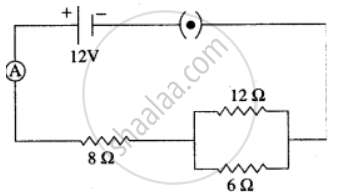Advertisements
Advertisements
प्रश्न
Three resistors are connected to a 12 V battery as shown in the figure given below:

(i) What is the current through the 8 ohm resistor?
(ii) What is the potential difference across the parallel combination of 6 ohm and 12 ohm resistor?
(iii) What is the current through the 6 ohm resistor?
उत्तर
(i) 6 ohm and 12 ohm are connected in parallel, So
⇒ `1/"R"_1 = 1/6 + 1/12 = (2 + 1)/12 = 3/12`
⇒ `1/"R"_1 = 1/4`
R1 = 4 ohm.
∴ Total Resistance R = 8 + 4 = 12 ohm.
Now ∵ V = IR
⇒ 12 = I × 12
∴ I = 1 Amp.
(ii) V = IR = 1 ×4 = 4 Volt
(iii) ∵ V = I1R
⇒ 4 = I1 × 6
∴ I1 = `4/6`
= 0.66 Amp.
APPEARS IN
संबंधित प्रश्न
State the relation between potential difference, work done and charge moved.
How much energy is transferred by a 12 V Power supply to each coulomb of charge which it moves around a circuit?
What is a voltmeter?
How is a voltmeter connected in the circuit to measure the potential difference between two points? Explain with the help of a diagram.
How does the resistance of a metallic wire depend on its temperature? Explain with reason.
A current of 0.2 A flows through a conducting wire for 5 minutes. How much charge will flow?
A current of 100 mA. flows through a wire. The charge on an electron is 1.6 × 10-19 C. Find the number of electrons passing per second through the cross-section of the conductor.
Conceptual question.
A bird sitting on a high power electric line is still safe. How?
A battery of 10 volt carries 20,000 C of charge through a resistance of 20 Ω. The work done in 10 seconds is:
Find out the following in the electric circuit given in Figure
- Effective resistance of two 8 Ω resistors in the combination
- Current flowing through 4 Ω resistor
- Potential difference across 4 Ω resistance
- Power dissipated in 4 Ω resistor
- Difference in ammeter readings, if any.

